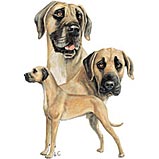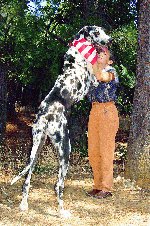|
GETTING THE FACTS ABOUT GREAT DANES IS AN IMPORTANT FIRST STEP TOWARDS DANE OWNERSHIP
If you're looking for facts about Great Danes this introduction page is probably the best place to start. These dogs are giants, but extremely gentle and while they are very popular as show dogs, they also make outstanding family pets. (Of course, they think they're human and if you don't give them the attention they need you end up with 30 IBs of dog head in your face, but who could resist that?) Cuteness and levity aside, anyone considering having one in their lives needs to research the facts about Great Danes first because it really is a unique dog commitment.
The average life span is seven to ten years, although it is not unheard of to go to twelve. The male grows to between 32 and 40 inches high at the shoulders, while the females are a bit smaller at 28 to 34. Males reach an average of 160 IBs (73kg) and the females 135 IBs (61kg). Of course, there are Danes that push 200 IBS (91kg) and in general, the European breeds are heavier than the North American. But even if you are dealing with only 135IBs of canine - that's still a lot of dog! Great Danes are people dogs. They don't do well if left outside or if they aren't an integral part of their human's lives. They are among the most loyal of dog breeds and absolutely adore their humans. And all they want -need- in return, is to be loved back. In researching the literature to put some of these facts about Great Danes together, we see that some Great Dane "experts" classify these dogs as extremely intelligent. Let's be upfront about this one; whoever wrote that was suffering a bit of denial. Great Danes are not particularly intelligent (ours forgets to move his leg out of the way when he eliminates) however as dogs that really need structure they are creatures of habit and can be trained. Probably a good thing they aren't the most intelligent dog breed - when you have to control a dog this size, you generally want to be smarter than the dog! Any collection of facts about Great Danes wouldn't be complete without a comment about their leaning. They aren't content to just stand beside you. For some reason they like to make contact with their body and lean. They use people, the way people use walls! If you move back a step, they are likely to move right with you! Not much of a problem for most adults, but it is a consideration for young children who can be inadvertently knocked down. Another characteristic that needs watching is the Dane tail. Great Danes get excited at the drop of a pin and the tail turns into a whip. Given the height of these dogs, lightning reflex -or a good cup - is a requirement in keeping the males of the household well protected! Danes are very malleable meaning the way they are raised affects their behavior. If you want a loving animal that behaves,love it and train it. Danes that are not shown love and spend most of their lives tied up in a yard are at risk to develop significant behavioral problems. There are Great Dane clubs all over Europe and North America. Great Dane Rescue organizations are also numerous and for good reason. There are too many stories of people not researching info about Great Danes before bringing a puppy home, only to discover after the fact that these dogs are unique. It costs money to feed them properly. Vet bills are more expensive for giant breeds. In many cases, people are scared away because the cute 25 IB puppy they bought grows into something they don't want to handle. Hundreds of Danes end up in rescue every year. So, you need to ask yourself, are Great Danes right for you? They are way more expensive than other breeds. They are more prone than other breeds to Hip Displasia, bloat and some other medical conditions. You can't just skip puppy training and basic obedience training. Giant dogs need to be controlled and they need to behave. And they only share our lives for an average of seven to ten years, so goodbys come far sooner than you want. But, if you appreciate the regal bearing of this animal. If you want a beautiful dog that will absolutely depend on you and adore you. If you want a dog that will turn heads wherever you go -both within the dog world and on the street. And if you can imagine how indescribably rewarding sharing life with one of these animals can be, then maybe Dane ownership should be part of your life. Examine the facts about Great Danes and make an informed decision.
Back to top of facts about Great Danes
|




 The Great Dane dog has been in Europe at least for the last 400 years and most believe was developed as a cross between a mastiff and a wolfhound.
The Great Dane dog has been in Europe at least for the last 400 years and most believe was developed as a cross between a mastiff and a wolfhound.
 The Great Dane is not the heaviest of dogs -mastiffs are generally heavier. And even though the tallest dog on record is a Great Dane named Gibson (who measured 42.2 inches at the shoulder and is pictured here towering 7 feet when standing on his hind legs), in general terms, wolf hounds are usually taller. But Danes have a very distinctive anatomy and it is a wonderful blend of size, muscle and bearing that make the Great Dane the "dog of dogs".
The Great Dane is not the heaviest of dogs -mastiffs are generally heavier. And even though the tallest dog on record is a Great Dane named Gibson (who measured 42.2 inches at the shoulder and is pictured here towering 7 feet when standing on his hind legs), in general terms, wolf hounds are usually taller. But Danes have a very distinctive anatomy and it is a wonderful blend of size, muscle and bearing that make the Great Dane the "dog of dogs".